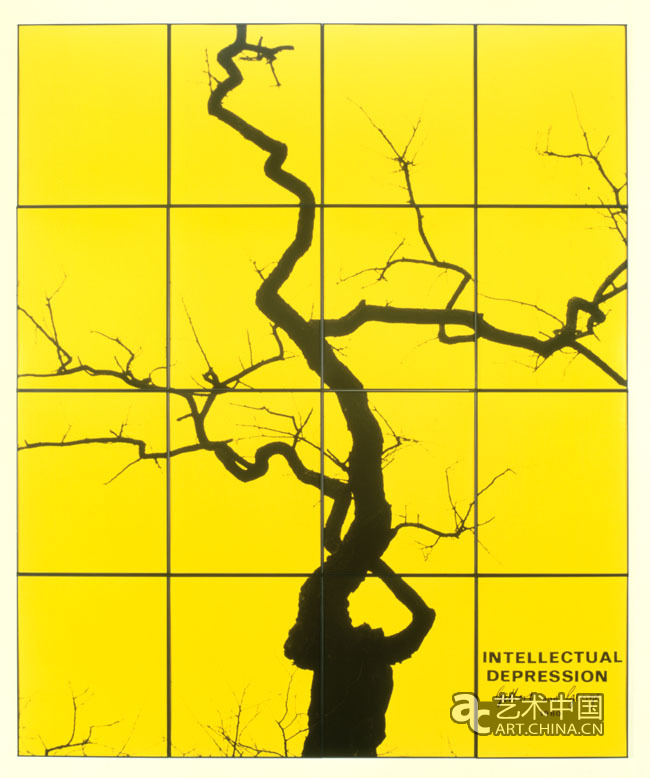吉爾伯特與喬治 -《精神壓抑》 |
| 藝術中國 | 時間: 2010-01-29 18:38:21 | 文章來源: 藝術中國 |
|
吉爾伯特與喬治 -《精神壓抑》 Gilbert & George Intellectual Depression 1980 Mixed media 242 x 202 cm 吉爾伯特和喬治 精神壓抑,1980 混合材料 242 x 202cm
這或許是吉爾伯特與喬治有關黑暗、畸形生長的比喻以及死亡和衰退運作觀的最突出畫作之一。在濃重的黃色背景上是一棵無葉樹的黑色輪廓,似乎向天空伸出扭曲的枝爪。這顆被特寫的樹長在倫敦的芬斯伯利圓形廣場,它是日本政府在第二次世界大戰後作為賠償贈予的禮物。樹上粗製的牌子細述了它的歷史,不過在吉爾伯特與喬治作畫後不久,樹和牌子被拆除了。這和同一時期的幾個相關研究與一些藝術家表現生命和活力的倉促之作形成了對比。 吉爾伯特與喬治是生活中和藝術上的夥伴,他們創造了一個世界,在這個世界裏,他們的所有存在即是一件藝術品。他們最初的作品是“唱歌的雕塑”(1969年),當時他們還是聖馬丁藝術學校的學生,他們一起邁開步子並隨大蕭條時代的歌曲“Underneath the Arches”高唱,從這個作品開始一直到他們永遠相互匹配的穿著,他們的整體統一性已經在很大程度上固定下來。他們是英國藝術的知名人物,雖然他們在某種程度上總是以局外人的形式存在——從不輕易遠離他們在東倫敦富爾尼耶大街(Fournier Street)的長期居所,每天的同一時間在同一個咖啡館進餐。吉爾伯特與喬治宣稱“全民藝術”,“藝術即生活”。正如他們用獨特的修辭風格所詮釋的那樣,藝術的主題“必須是人類的狀況,我們把人類狀況看作最高理想。人是萬物之中最奇妙的東西,同時藝術的整個形式(顏色和形式)只是用來服務主題,其本身沒有什麼重要性。我們討厭為藝術而藝術——我們完全反對這種觀點”。[注:與喬治與Irmeline Lebeer的談話,《藝術雜誌》(Art Press)] 吉爾伯特與喬治記錄了四十多年來現代生活,生活中的方方面面——包括意外打擊、惡俗、神聖以及放浪形骸——都一一收錄他們共同的作品之中。不過,1980年,藝術家關注的主題,主要是宗教和絕望——荒蕪空虛的生活信仰。20世紀70年代期間,藝術家的作品充滿了苦悶並逐漸向壓抑、酒精和瘋狂等較為陰暗的主題轉換,並從早期畫作《樹枝》(Branch)(1978年)提取主題。在《樹枝》中,一個光禿禿的樹枝簡單輪廓出現在藝術家頭上面的紅色背景上。 然而,隨著這種主題的發展,藝術家的色彩開始豐富起來。最近,吉爾伯特與喬治從黑白單一的圖像走出,開始發展一種利用深紅色的方法。被稱為蕭條之年的1980年是他們在相關作品《等待》(Waiting)中使用黃色的第一年。這些顏色(涂在深色的格狀結構中)的深度和豐富性製造出彩色玻璃窗戶的效果。正如Suzanne Pagé所指出的,“吉爾伯特與喬治同中世紀的藝術家一樣,創造了各種形象來使人了解和解釋。”我們可以想像,這幅作品所宣揚的訊息是一種警告。1980年的許多畫作涉及生活恐懼的美學觀,黃色和黑色的使用機會使人生厭,讓人想起危險的標誌。對於這些有預見性的藝術家而言,他們預見了充滿恐懼的時代即將到來,這幅早期畫作告訴我們,這種恐懼的環境會對精神對靈魂産生鉗製作用。 勞拉•麥克利恩•法裏斯 Gilbert & George This is perhaps one of Gilbert & George’s starkest pictures, concerned with imagery of a dark, malformed growth, and orbiting notions of death and decay. A black silhouette of a skeletal leafless tree appears on a rich yellow background, seeming to raise a twisted claw to the sky. The featured tree grew in Finsbury Circus in London, and was a gift from the Japanese government as reparation after World War II. A poorly-made plaque on the tree detailed its history, though both tree and plaque were removed shortly after Gilbert & George’s picture was made. This, along with several related studies from the same period, contrasts with some of the artists’ brasher pictures, which teem with life and activity. Gilbert & George, partners in life and art, have created a universe in which their entire existence is an artwork. From their very first ‘Singing Sculpture’ (1969), made whilst still students at St Martin’s School of Art, and in which they move in synch and sing along with the Depression-era song ‘Underneath the Arches’, through to their unfashionably matching tailoring, their entirety is heavily formalised. They are well-known icons of British art, although they have always, to some extent, existed as outsiders – never venturing very far from their long-term residence in Fournier Street, East London, and eating in the same cafe every day at the same time. ‘Art is for All,’ claim Gilbert & George, and ‘Art is Life.’ As they explain in their inimitable rhetorical style, the subject matter of art ‘must be the human condition: we believe in the human condition as the supreme ideal. Man is the most amazing thing of all and the whole formal side of art – colours and forms – is there only to serve the subject and is of no importance in itself. We hate art for art’s sake – we are totally opposed to it.’ Gilbert & George have been chroniclers of modern life for more than 40 years; and huge swathes of life - shock, shits, crucifixes and hoodies - have met within the confines of their signature grid. The themes that concerned the artists in 1980, however, are governed by the twin poles of religion and despair – a faith in life which is bleak and empty. Intellectual Depression is prefigured by a gradual move during the 1970s towards darker themes such as depression, alcohol and madness, and draws on a motif of an earlier picture, Branch (1978) , in which the austere silhouette of a naked branch appears against a red background above the heads of the artists. Alongside these thematic developments, however, was the start of a new kind of richness in the artists’ palette. Gilbert & George had recently moved away from black and white monochrome images, and had begun to develop a process employing a deep red. The year of Intellectual Depression, 1980, was the first that they used the colour yellow, in a related picture, Waiting. The depth and richness of these hues, fixed within a dark grid-like structure, creates the impression of stained-glass windows. As Suzanne Pagé has noted, ‘Like the artists of the Middle Ages, Gilbert & George create images to initiate and explain.’ We might imagine that the message preached in this work is a type of warning. Many pictures from 1980 concern the aesthetics of living with fear, and the use of yellow and black is almost sickly, recalling a hazard sign or a wasp. For such prescient artists, who prefigured an age in which terror would have such an inflated currency, this early picture barks a lesson at us about the effect of strangulation that any such climate of fear has on the intellect, and on the soul. Laura McLean-Ferris
|
| 注:凡註明 “藝術中國” 字樣的視頻、圖片或文字內容均屬於本網站專稿,如需轉載圖片請保留 “藝術中國” 浮水印,轉載文字內容請註明來源藝術中國,否則本網站將依據《資訊網路傳播權保護條例》維護網路智慧財産權。 |
